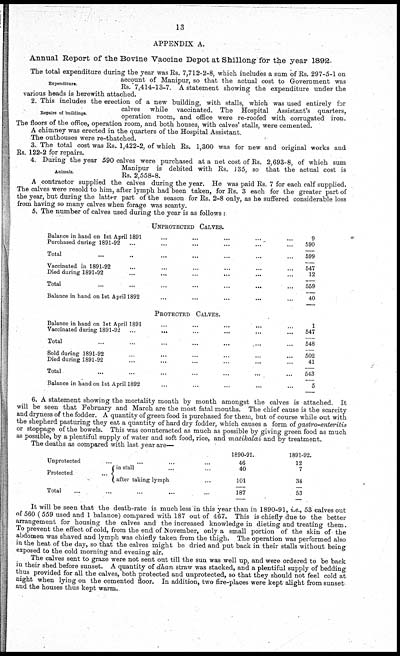Medicine - Vaccination > 1874-1927 - Annual vaccination report of the province of Assam > Vaccination report Assam 1874-1896 > 1891-1892 - Annual vaccination report of the Province of Assam for the year 1891-92
(389) Page 13
Download files
Individual page:
Thumbnail gallery: Grid view | List view

13
APPENDIX A.
Annual Report of the Bovine Vaccine Depot at Shillong for the year 1892.
Expenditure.
The total expenditure during the year was Rs. 7,712-2-8, which includes a sum of Rs. 297-5-1 on
account of Manipur, so that the actual cost to Government was
Rs.7,414-13-7. A statement showing the expenditure under the
various heads is herewith attached.
Repairs of buildings.
2. This includes the erection of a new building, with stalls, which was used entirely for
calves while vaccinated. The Hospital Assistant's quarters,
operation room, and office were re-roofed with corrugated iron.
The floors of the office, operation room, and both houses, with calves' stalls, were cemented.
A chimney was erected in the quarters of the Hospital Assistant.
The outhouses were re-thatched.
3. The total cost was Rs. 1,422-2, of which Rs. 1,300 was for new and original works and
Rs. 122-2 for repairs.
Animals.
4. During the year 590 calves were purchased at a net cost of Rs. 2,693-8, of which sum
Manipur is debited with Rs. 135, so that the actual cost is
Rs. 2,558-8.
A contractor supplied the calves during the year. He was paid Rs. 7 for each calf supplied.
The calves were resold to him, after lymph had been taken, for Rs. 3 each for the greater part of
the year, but during the latter part of the season for Rs. 2-8 only, as he suffered considerable loss
from having so many calves when forage was scanty.
5. The number of calves used during the year is as follows :
|
UNPROTECTED CALVES. |
|
|
Balance in hand on 1st April 1891 ... ... ... ... ... |
9 |
|
Purchased during 1891-92 ... ... ... ... ... ... |
590 |
|
Total ... ... ... ... ... ... ... |
599 |
|
Vaccinated in 1891-92 ... ... ... ... ... ... |
547 |
|
Died during 1891-92 ... ... ... ... ... ... |
12 |
|
Total ... ... ... ... ... ... ... |
559 |
|
Balance in hand on 1st April 1892 ... ... ... ... ... |
40 |
|
PROTECTED CALVES. |
|
|
Balance in hand on 1st April 1891 ... ... ... ... ... |
1 |
|
Vaccinated during 1891-92 ... ... ... ... ... |
547 |
|
Total ... ... ... ... ... ... ... |
548 |
|
Sold during 1891-92 ... ... ... ... ... ... |
502 |
|
Died during 1891-92 ... ... ... ... ... ... |
41 |
|
Total ... ... ... ... ... ... ... |
543 |
|
Balance in hand on 1st April 1892 ... ... ... ... ... ... |
5 |
6. A statement showing the mortality month by month amongst the calves is attached. It
will be seen that February and March are the most fatal months. The chief cause is the scarcity
and dryness of the fodder. A quantity of green food is purchased for them, but of course while out with
the shepherd pasturing they eat a quantity of hard dry fodder, which causes a form of gastro-enteritis
or stoppage of the bowels. This was counteracted as much as possible by giving green food as much
as possible, by a plentiful supply of water and soft food, rice, and matikalai and by treatment.
The deaths as compared with last year are—
|
1890-91. |
1891-92. |
||
|
Unprotected ... ... ... ... |
46 |
12 |
|
|
Protected ... |
install ... ... |
40 |
7 |
|
after taking lymph ... |
101 |
34 |
|
|
Total ... ... ... ... ... |
187 |
53 |
|
It will be seen that the death-rate is much less in this year than in 1890-91, i.e., 53 calves out
of 560 (559 used and 1 balance) compared with 187 out of 467. This is chiefly due to the better
arrangement for housing the calves and the increased knowledge in dieting and treating them.
To prevent the effect of cold, from the end of November, only a small portion of the skin of the
abdomen was shaved and lymph was chiefly taken from the thigh. The operation was performed also
in the heat of the day, so that the calves might be dried and put back in their stalls without being
exposed to the cold morning and evening air.
The calves sent to graze were not sent out till the sun was well up, and were ordered to be back
in their shed before sunset. A quantity of dhan straw was stacked, and a plentiful supply of bedding
thus provided for all the calves, both protected and unprotected, so that they should not feel cold at
night when lying on the cemented floor. In addition, two fire-places were kept alight from sunset
and the houses thus kept warm.
Set display mode to: Large image | Zoom image | Transcription
Images and transcriptions on this page, including medium image downloads, may be used under the Creative Commons Attribution 4.0 International Licence unless otherwise stated. ![]()
| Permanent URL | https://digital.nls.uk/91525255 |
|---|
| Additional NLS resources: | |
|---|---|
| Attribution and copyright: |
|
|---|




